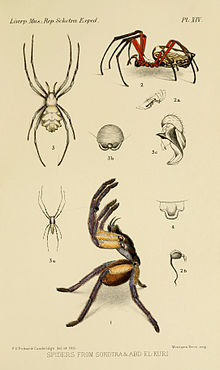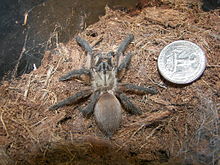Blue Yemen tarantula
| Blue Yemen tarantula | ||||||||||||
|---|---|---|---|---|---|---|---|---|---|---|---|---|

Blue Yemen tarantula ( Monocentropus balfouri ), female |
||||||||||||
| Systematics | ||||||||||||
|
||||||||||||
| Scientific name | ||||||||||||
| Monocentropus balfouri | ||||||||||||
| Pocock , 1897 |
The Yemen blue tarantula ( Monocentropus balfouri ) is a spider in the tarantula family (Theraphosidae). The species is endemic to the island of Socotra, which belongs to the Republic of Yemen and is located in the Indian Ocean . The Yemen blue tarantula has gained a certain reputation for its unusual social way of life for spiders, including its brood care behavior .
The common English name of the Yemen blue tarantula is Socotra Island Blue Baboon Tarantula (translated roughly " Socotra Island Blue Baboon Tarantula ").
features

The Yemen blue tarantula reaches a body length of around 50 to 70 millimeters and is therefore one of the medium-sized tarantulas. The leg span is around 170 to 180 millimeters.
The species has a distinctive color scheme. The carapace (back shield of the prosoma or front body) is colored blue-gray and has an almost turquoise shimmer. The legs are of the tarsus (foot members) to the patellae (limbs from the tibias uniformly colored blue (Greaves)). From the femora (limbs) the blue color changes into a beige-gray.
The opisthosoma (abdomen) also has a beige-gray basic color, although the spinnerets are again colored blue.
Occurrence

The Yemen blue tarantula is endemic to the island of Socotra , which belongs to the Republic of Yemen and is located in the Indian Ocean and located in the ocean near the Gulf of Aden .
Habitats
The Yemen blue tarantula is preferred to be found near the coast. However, it can also occur at heights of up to 850 meters above sea level. According to its way of life, the Yemen blue tarantula predominantly lives on the ground in its habitat .
Threat and protection
No information is available about possible threats to the population of the Yemen blue tarantula, as their populations are not assessed by the IUCN . Accordingly , it is not subject to any protection status . It is assumed, however, that excessive removal of the species from its rather small range for the purpose of keeping pets (see section " Terraristics ") can endanger the species' populations.
Way of life
The Yemen blue tarantula is one of the ground-dwelling tarantulas and, like many other species in the family, digs up living tubes or takes on existing hiding places. In both cases the shelter is lined with a web . It is believed that the Yemen blue tarantula in the wild gives up its old shelter after each molt and builds a new one.
Like all tarantulas, the Yemen blue tarantula is nocturnal and usually stays hidden during the day. At this time she prefers to stay in her shelter, while at night she lurks for prey at its entrance.
Hunting behavior and range of prey
The hunting behavior of the predatory blue Yemen tarantulas - like almost all spiders - corresponds to that of other ground-dwelling tarantulas. The spider lives as a stalker and prefers to stay at the mouth of the residential tube during its nocturnal activity time. As is usual for tarantulas, it perceives prey primarily by means of vibrations. For this it is equipped with sensilla (sensory hair). If the prey comes within range, the tarantula will jump at it and give it a poisonous bite.
As with other medium-sized tarantulas, the range of prey for the Yemen blue tarantula is quite diverse and includes other arthropods in particular , including larger and more defensive species that are also predatory like centipedes or scorpions . Smaller vertebrates , including reptiles , amphibians and rodents in suitable sizes, expand the range of prey for the species.
social behaviour
The Yemen blue tarantula is one of the few spiders, including tarantulas, with a social way of life and a correspondingly low level of intraspecific aggressiveness. Therefore, several individuals of the species can be found in the immediate vicinity, each using their own refuge there without cannibalism occurring. The social behavior is also visible in brood care (see section " Hatching and brood care ").
Defense behavior
The Yemen blue tarantula is a rather shy species of the family and tries to flee in the event of disturbances, such as encounters with predators (predators). If this is not possible, the species adopts the threatening gesture typical of tarantulas , in which the spider stands up and raises the first pair of legs and the pedipalps (transformed extremities in the head area). The spider also hits attackers with its raised extremities. The species has a poison bite as its last defense option.
Females guarding their egg cocoons show an increased willingness to defend themselves and can go over to direct defense without warning.
Life cycle
The life cycle of the Blue Yemen tarantula is as divided in many spiders over several phases and also sometimes depending on the seasons.
Mating and laying eggs
The mating season of the Yemen blue tarantula takes place between December and February. The mating behavior of the species does not differ from that of other tarantulas. The male approaches the female cautiously at first, but is no longer shy as soon as the actual mating begins. Often times, both sexes interact with each other several times during mating.
Six to eight weeks after mating (between February and April) the female lays an egg cocoon in its hiding place , which can contain 20 to 40 eggs. This means that the number of eggs in the Yemen blue tarantula cocoon is comparatively very low. However, if there is enough sperm that the male transferred during mating, the female can make a second egg cocoon.
Hatching and brood care
The young hatch after 38 to 42 days and remain with their mother for the time being. Unusually for tarantulas, the juveniles of the Yemen blue tarantula go through three instead of two larval stages.
The Yemen blue tarantula shows an unusual brood care behavior for tarantulas . The mother kills prey and hands them to her offspring in an already shredded state, which then makes it easier for the young to take in. The young animals stay with their mother for a few months and up to the second skin and then leave their shelter to live independently.
Growing up and life expectancy
The females of the Yemen blue tarantula need about two years to reach sexual maturity, the males less, as is usual for tarantulas, and can be fully grown after seven months if feeding conditions are good. As with other tarantulas, the maximum life expectancy of females is a good 10 to 14 years, which is significantly longer than that of males, which is only around three to four years.
Blue Yemen tarantula and human
The Yemen blue tarantula has a different reputation with different people, which also varies depending on the part of the country and tradition.
Calling on Socotra and Myths
The Yemen blue tarantula is mostly feared by the indigenous people of Socotra, as it is rumored that the spider's poison is enough to kill a camel . Although the effect of the poison of the species has never been scientifically proven, it is very unlikely. The toxicity (effect) of the poisons of tarantulas is, with few exceptions, normally not sufficient to cause medically relevant symptoms in larger mammals such as camels or in humans.
Terrariums
The Yemen blue tarantula is popular in keeping pets in the field of terraristics , which is due to its distinctive appearance and is also due to its social and brood-care behavior. For successful keeping, a correspondingly deeper subsoil suitable for digging must be procured and the rather dry and warm climate of their natural occurrence area must be simulated, whereby the artificial habitat must never dry out completely and there should also be drinking opportunities for the spiders. When keeping several specimens, a correspondingly larger container is necessary. In terraristics, the common attitude of a breeding association has proven itself to prevent cannibalism as much as possible.
When breeding the species in captivity, it is important that the young animals are left with their mother for the time being so that they can grow up successfully, as they are initially not yet viable on their own. The majority of attempts at rearing pups that had lost their mother resulted in the quick death of the pups.
The first offspring of the species have been in captivity since around 2010, which simplifies the procurement of specimens of the Yemen blue tarantula, simplifies maintenance and also puts less strain on wild populations.
Systematics
The Yemen blue tarantula was first described by Reginald Innes Pocock in 1897 and has not seen any name changes or conversions since then. It is also the type of the genus Monocentropus . The species name honors the discoverer of the spider, Sir Isaac Bayley Balfour , who led a scientific expedition to Socotra in 1880. At that time there was great interest in the island's peculiar flora and fauna, so that the Imperial Academy of Sciences in Vienna also sent a scientific expedition to the island.
gallery
Male suffering from the so-called dyskinetic syndrome with visible muscle contractions
Individual evidence
- ↑ a b c d e f g h i j k l m n o Monocentropus balfouri (Pocock, 1897) from Theraphosidae (Dutch), accessed on June 22, 2020.
- ↑ a b c Monocentropus balfouri (Pocock, 1897) at Arachnophilia.de, accessed on June 22, 2020.
- ↑ a b c d e f Monocentropus balfouri (Pocock, 1897) from Animal Scene, accessed June 22, 2020.
- ↑ a b Monocentropus balfouri (Pocock, 1897) at REPTALE.de, accessed on June 22, 2020.
- ↑ Monocentropus balfouri (Pocock, 1897) from Tarantupedia, accessed June 22, 2020.
- ↑ a b Monocentropus balfouri (Pocock, 1897) at herbertsspiderworlds, accessed on June 22, 2020.
- ↑ a b c d Monocentropus balfouri (Pocock, 1897) from Crisanta Hoffmann - spiders.hxnetz.de, accessed on June 22, 2020.
- ↑ a b c I. Wendt, BF Striffler and F. Schneider: Social tarantulas? - Part 2 examples from Asia and Europe , Terraria (31), 2011, pp. 64–69, accessed on June 22, 2020.
- ↑ Monocentropus balfouri (Pocock, 1897) from Crisanta Hoffmann - spiders.hxnetz.de, accessed on June 22, 2020.
- ^ Isaac Bayley Balfour: Report of the Socotra Committee of the British Association for the Advancement of Science of the proceedings of the Expedition to the Island of Socotra. Report of the Fiftieth meeting of the British Association for the Advancment of Science 1880, pp. 212-216, John Murray, London 1881.
literature
- Hans W. Kothe: tarantulas. 1st edition, Franckh-Kosmos, Stuttgart 2003, ISBN 3-4400-9367-0 .
- Volker von Wirth: tarantulas. 1st edition. Gräfe and Unzer, Munich 2011, ISBN 978-3-8338-2151-6 .
- I. Wendt, BF Striffler and F. Schneider: Social tarantulas? - Part 2 examples from Asia and Europe , Terraria (31), 2011, pp. 64–69.
Web links
- Monocentropus balfouri in the World Spider Catalog
- Monocentropus balfouri (Pocock, 1897) at the Global Biodiversity Information Facility
- Monocentropus balfouri (Pocock, 1897) at Tarantupedia
- Monocentropus balfouri (Pocock, 1897) in Theraphosidae (Dutch)
- Monocentropus balfouri (Pocock, 1897) at Arachnophilia.de
- Monocentropus balfouri (Pocock, 1897) at Animal Scen
- Monocentropus balfouri (Pocock, 1897) at REPTALE.de
- Monocentropus balfouri (Pocock, 1897) at herbertsspiderworlds
- Monocentropus balfouri (Pocock, 1897) at Crisanta Hoffmann - spiders.hxnetz.de





